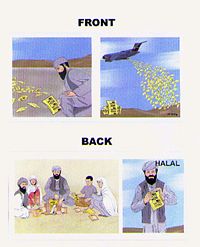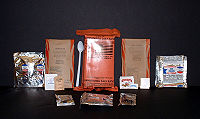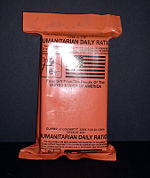Humanitarian daily ration: Difference between revisions
Jump to navigation
Jump to search

imported>Derek Hodges (sp.) |
imported>Meg Taylor m (spelling: diasters -> disasters) |
||
| (4 intermediate revisions by 2 users not shown) | |||
| Line 1: | Line 1: | ||
{{subpages}} | {{subpages}} | ||
{{Image|Human daily ration leaflet as distributed in Afghanistan.jpg|right|200px|Instructions intended for Afghan refugees for human daily rations.{{Human daily ration leaflet as distributed in Afghanistan.jpg/credit}}}} | |||
[[Image:Humanitarian daily rations and contents.jpg|thumb|Humanitarian daily rations and contents | [[Image:Humanitarian daily rations and contents.jpg|thumb|200px|Humanitarian daily rations and contents.]] | ||
'''Humanitarian daily ration''' is the name for an emergency ration, with a long shelf-life,<ref name=DSCAJudithMccallum> | |||
''' | |||
{{cite news | {{cite news | ||
| url=http://www.disam.dsca.mil/pubs/Journal%20Index/journals/Journal_Index/v.23_2/McCallum_Human_Daily_Ration.pdf | | url=http://www.disam.dsca.mil/pubs/Journal%20Index/journals/Journal_Index/v.23_2/McCallum_Human_Daily_Ration.pdf | ||
| title=Humanitarian Daily Rations: Being Ready is Half the Battle | | title=Humanitarian Daily Rations: Being Ready is Half the Battle | ||
| publisher=[[Defense Security Cooperation Agency]] | | publisher=[[Defense Security Cooperation Agency]] | ||
| author= | | author=Judith McCallum | ||
| date=Winter 2001 | | date=Winter 2001 | ||
| accessdate=2007-10-18 | | accessdate=2007-10-18 | ||
}}</ref> | }}</ref> intended to be used for refugees | ||
during natural disasters, or in conflict areas.<ref name=DlaMilHumanDailyRation> | |||
{{cite web | {{cite web | ||
| url=http://www. | | url=http://www.dscp.dla.mil/subs/rations/programs/tdsevn.pdf | ||
| title= | | title=Technical Data for Humanitarian Daily Ration | ||
| publisher=[[ | | publisher=[[U.S. Department of Defense]] | ||
| accessdate=2007-10-18 | | accessdate=2007-10-18 | ||
}}</ref> | }}</ref> | ||
The meals are designed to be able to survive being air-dropped, without a parachute.<ref name=DcsaHumanitarianDailyRations> | The meals are designed to be able to survive being air-dropped, without a parachute.<ref name=DcsaHumanitarianDailyRations> | ||
{{cite web | {{cite web | ||
| url=http://www.dsca.mil/programs/HA/HUMANITARIAN%20DAILY%20RATIONS.pdf | | url=http://www.dsca.mil/programs/HA/HUMANITARIAN%20DAILY%20RATIONS.pdf | ||
| title=Humanitarian Daily Rations | | title=Humanitarian Daily Rations | ||
| publisher=[[ | | publisher=DCSA | ||
| accessdate=2007-10-18 | |||
}}</ref> | |||
This is safer for the refugees than parachuting large pallets of rations. And it prevents hoarding of the meals by a few individuals. The meals cost approximately 20 % the cost of a [[meal ready to eat]].<ref name=DefenseLogisticsAgencyOperationalRations> | |||
{{cite web | |||
| url=http://www.dscp.dla.mil/subs/rations/programs/hdr/hdrabt.asp | |||
| title=Operational Rations | |||
| publisher=[[United States Defense Logistics Agency]] | |||
| accessdate=2007-10-18 | | accessdate=2007-10-18 | ||
}}</ref> | }}</ref> | ||
Initially the rations came in a yellow wrapper, but that was the same color as a [[cluster submunition|antipersonnel cluster submunition]]. The color was changed so civilians would not pick up a dangerous unexploded munition thinking it was food. | |||
<ref name=QuartermastAlphabetSoup>{{cite news | |||
Initially the rations came in a yellow wrapper, but that was the same color as a [[cluster | |||
{{cite news | |||
| url=http://www.quartermaster.army.mil/oqmg/professional_bulletin/2001/Winter01/The_Alphabet_Soup_of_Combat_Rations.htm | | url=http://www.quartermaster.army.mil/oqmg/professional_bulletin/2001/Winter01/The_Alphabet_Soup_of_Combat_Rations.htm | ||
| title=The Alphabet Soup of Combat Rations | | title=The Alphabet Soup of Combat Rations | ||
| publisher=[[United States Army]] | | publisher=[[United States Army]] | ||
| author= | | author=Albin R. Majewski | ||
| date=Winter 2001 | | date=Winter 2001 | ||
| accessdate=2007-10-18 | | accessdate=2007-10-18 | ||
}}</ref> | }}</ref> | ||
{| class="wikitable" | {| class="wikitable" | ||
|+ '''Specifications''' | |+ '''Specifications'''<ref name=DefenseLogisticsAgencyOperationalRations/> | ||
|- | |- | ||
| '''Shelf life''' || 36 months at 80 F | | '''Shelf life''' || 36 months at 80 F | ||
| Line 77: | Line 72: | ||
| '''Utensils'''' || All rations contain a spoon and a paper towel moistened with a non-toxic, non-alcoholic cleanser | | '''Utensils'''' || All rations contain a spoon and a paper towel moistened with a non-toxic, non-alcoholic cleanser | ||
|} | |} | ||
{{Image|Salmon colored Humanitarian Daily Ration.jpg|left|150px|Salmon colored Humanitarian Daily Ration.}} | |||
The rations were first used in [[Bosnia (country)|Bosnia]] in 1993.<ref name=Defenselink19950802> | |||
{{cite web | |||
| url=http://www.defenselink.mil/news/Aug1995/m080295_m-174-95.html | |||
| title=Memorandum for Correspondents | |||
| publisher=[[United States Department of Defense]] | |||
| date=August 2, 1995 | |||
| accessdate=2007-10-18 | |||
}}</ref> | |||
==References== | ==References== | ||
<references/> | <references/> | ||
Latest revision as of 00:53, 7 February 2010
Humanitarian daily ration is the name for an emergency ration, with a long shelf-life,[1] intended to be used for refugees during natural disasters, or in conflict areas.[2]
The meals are designed to be able to survive being air-dropped, without a parachute.[3] This is safer for the refugees than parachuting large pallets of rations. And it prevents hoarding of the meals by a few individuals. The meals cost approximately 20 % the cost of a meal ready to eat.[4]
Initially the rations came in a yellow wrapper, but that was the same color as a antipersonnel cluster submunition. The color was changed so civilians would not pick up a dangerous unexploded munition thinking it was food. [5]
| Shelf life | 36 months at 80 F |
| Weight | 30 ounces |
| Kilo Calories | at least 2200 per package |
| Protein content | 10-13 percent |
| Fat content | 27-30 percent |
| Carbohydrate content | 60 percent |
| Prohibited contents | Any animal products, except a limited amount of dairy products, below the limit that would cause a problem for a person with lactose intolerance. |
| Infant component | All rations contain a fruit paste, suitable for feeding to infants |
| Utensils' | All rations contain a spoon and a paper towel moistened with a non-toxic, non-alcoholic cleanser |
The rations were first used in Bosnia in 1993.[6]
References
- ↑ Judith McCallum. Humanitarian Daily Rations: Being Ready is Half the Battle, Defense Security Cooperation Agency, Winter 2001. Retrieved on 2007-10-18.
- ↑ Technical Data for Humanitarian Daily Ration. U.S. Department of Defense. Retrieved on 2007-10-18.
- ↑ Humanitarian Daily Rations. DCSA. Retrieved on 2007-10-18.
- ↑ 4.0 4.1 Operational Rations. United States Defense Logistics Agency. Retrieved on 2007-10-18.
- ↑ Albin R. Majewski. The Alphabet Soup of Combat Rations, United States Army, Winter 2001. Retrieved on 2007-10-18.
- ↑ Memorandum for Correspondents. United States Department of Defense (August 2, 1995). Retrieved on 2007-10-18.


